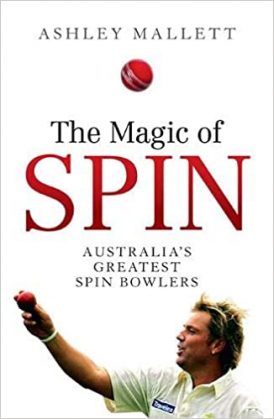The Magic of Spin
Martin Chandler |Published: 2019
Pages: 275
Author: Mallett, Ashley
Publisher: Hardie Grant
Rating: 3.5 stars

I am not even going to attempt to count the number of cricket books there are that can be described as ‘collected biography’. The rationale for why this is the case seems to me to be twofold. First of all I imagine, as they cover a broad subject matter, that they tend to sell reasonably well. Perhaps more importantly they are books that are not unduly taxing to write – anyone who is a half decent wordsmith and has a substantial library will be able to put such a book together in short order.
Is this a bad thing? Personally I don’t believe so, as even if it will seldom attract too many accolades from reviewers this sort of book will usually provide an excellent introduction to cricket literature, and encourage its reader to move on and explore the subject further.
Having worked for a number of years as a journalist, and having authored around twenty books of his own, Ashley Mallett was undoubtedly a fine writer, and I have no doubt that over the years he would have amassed a substantial number of books on the game. But Mallett of course had one other priceless attribute. He was an accomplished player himself and, until Nathan Lyon came along, Australia’s finest post war finger spinner.
The Magic of Spin was Mallett’s penultimate book, appearing two years ago. There was another book, Thwack!, that appeared between it and Mallett’s final book*, his recent biography of Neil Harvey, but Thwack! was essentially an anthology, the individual pieces in it spanning the whole of Mallett’s writing career. Having written a couple of autobiographies, and lives of the likes of Harvey, Clarrie Grimmett, Ian Chappell, Doug Walters and Jeff Thomson I rather doubt that The Magic of Spin will be the title for which Mallett is best remembered, but nonetheless it has much to commend it, and is certainly a cut above most titles of its type.
As its title makes clear the book concentrates on those who share Mallett’s own cricketing specialism, that of spin bowling. All who practice the art are eligible, both right and left handed, and whether of the finger, wrist or, in the case of Jack Iverson and Johnny Gleeson, ‘mystery’ varieties.
For the purposes of his book Mallett divides the game into seven eras, rather than any other classification. He spends a page or two on each by way of introduction, but the bulk of the book is 43 pen portraits, starting with George Giffen and ending with Lyon.
And the key to Mallett’s success is, not surprisingly, that although he clearly has referred to a few books (there is a modest bibliography listing a number of well known books) most of the narrative has come from the primary source of Mallett himself. Of those 43 only thirteen are pre war, and of those one is Grimmett who, as noted, has already been the subject of a full biography from Mallett and who Mallett knew well, having sought him out as a youngster looking for advise.
Turning to those whose careers came after the Second World War then one way or another Mallett knew them all, some just through watching them himself, but others because he played with or against them, and for those after his time he has, in the way that Grimmett did for him, played the mentoring role whenever called upon to do so. The effect is that without exception these essays contain insights, observations and explanations that you would not ordinarily see in biographical sketches.
The first part of the book deals with Giffen, ‘Terror’ Turner, Bill Howell, Monty Noble and Hugh Trumble. They are an illustrious band but, as far as I am aware, there is no footage of any of them in action. Most sources are not entirely helpful in assisting the reader to understand what sort of deliveries these men produced, other than in general terms. This is an area where Mallett’s understanding of the spinner’s art enables him to unravel historic writings and enlighten his reader as to what sort of deliveries each man produced.
The personal impressions that appear in relation to all of the post war spinners mean that The Magic of Spin gives up something of its author anyway, but there is also a chapter, not unnaturally rather different in approach to the others, on the subject of Mallett himself. Given that the two autobiographies to which I refer, Rowdy and Spin Out, appeared as long ago as 1973 and 1977, and Mallett sadly died in October of last year, the book does represent the last we will read of Mallett on Mallett, and there is value in that in itself.
Some of the more illuminating essays in The Magic of Spin are on the subject of some of the less well known, and for those of us interested in the influx of Australian spinners to county cricket after the war Bruce Dooland, George Tribe, Colin McCool and Cec Pepper are all featured. It is a pity Vic Jackson, Jack Walsh and John McMahon were not included as well, although I appreciate a line had to be drawn somewhere.
Of all the essays in the book the one that in many ways is the most enjoyable is that dealing with Lyon, whose back story and early travails with his action I had no idea about. It is a shame about what I will describe as a ‘continuity error on the final page of that does rather jar, but that apart the book is a fine read, and much more than a simple introduction to the spinner’s art.
*But not quite the end of his published work, as a contribution to the Cricketers in Print series, The D’Artagnan of Australian Cricket on the subject of Les Favell, will be published very soon.






Leave a comment